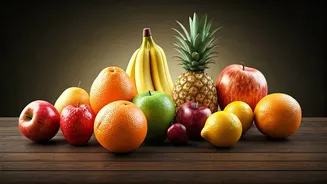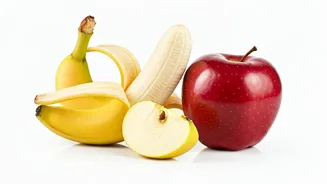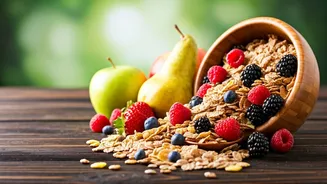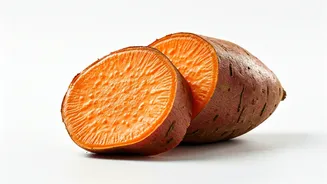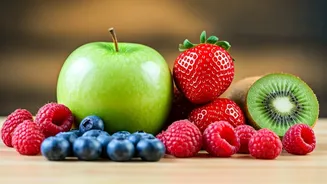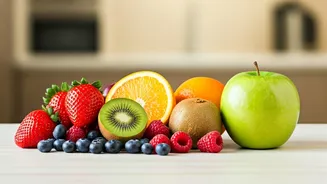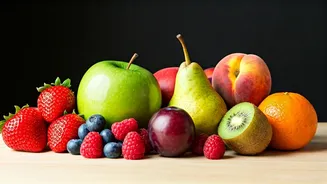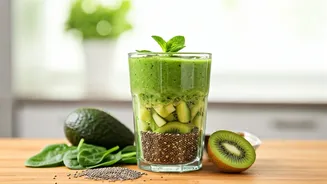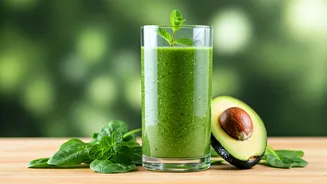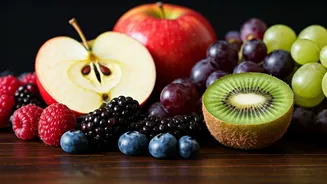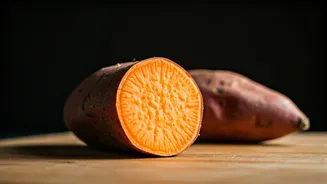Embracing Fruity Delights
Diabetes management often involves careful dietary choices, leading to misconceptions about fruit consumption. The common belief is that the natural sugars
in fruits make them unsuitable for those managing blood sugar levels. However, a closer look reveals that not all fruits are created equal, and many can be enjoyed in moderation as part of a balanced diet. This is due to variations in their glycemic index (GI) and glycemic load (GL), which measure how quickly a food raises blood sugar. Fruits with a lower GI and GL can be consumed in appropriate portions without causing rapid spikes in blood sugar. These fruits also often come packed with essential nutrients like fiber, vitamins, and antioxidants, further supporting overall health. Therefore, incorporating the right types of fruit can be a flavorful and nutritious way to maintain a healthy lifestyle while managing diabetes.
Berries: Tiny Treasures
Berries are often recommended as an excellent choice for individuals with diabetes due to their low GI and high fiber content. This combination helps to slow down the absorption of sugar, preventing sudden blood sugar spikes. Consider strawberries, for example. They offer a good source of vitamin C and antioxidants. Blueberries are another fantastic option, loaded with antioxidants that may protect against cellular damage. Raspberries, with their high fiber content, are also beneficial, aiding in digestive health and blood sugar control. Blackberries provide a similar nutritional profile, offering a delicious way to get essential vitamins and minerals. The versatility of berries makes them easy to incorporate into meals and snacks. Berries can be added to yogurt, cereal, or consumed as a standalone snack. The variety of berries ensures a burst of flavor and a boost of nutrients that contribute to a healthy, diabetes-friendly diet.
Cherries: Sweet & Savvy
Cherries, especially tart cherries, are another fruit that can be included in a diabetes-friendly diet. While they are slightly higher in natural sugars compared to berries, they still offer several health benefits. Cherries have a moderate GI, meaning they won't cause a dramatic increase in blood sugar if consumed in reasonable portions. They are also packed with antioxidants and anti-inflammatory compounds. The antioxidants in cherries can help protect cells from damage and reduce the risk of chronic diseases. Moreover, tart cherries are known for their potential to improve sleep quality, which is crucial for overall health and blood sugar management. When choosing cherries, opt for fresh or frozen varieties and avoid those with added sugars or heavy syrups. Incorporating a small portion of cherries into your diet can provide sweetness and valuable nutrients without significantly impacting blood sugar levels.
Apples: Everyday Champion
Apples are widely accessible and offer a convenient way to include fruit in your diet. They are a good source of fiber, particularly soluble fiber, which helps slow down the digestion and absorption of sugar. This contributes to better blood sugar control. Apples have a moderate GI, so moderation is key. Eating apples with the skin intact adds extra fiber, supporting digestive health and helping you feel full longer. Apples also provide essential vitamins and minerals, contributing to overall health. Varieties like Granny Smith have a lower sugar content and are thus a better choice. When adding apples to your diet, consider combining them with a source of protein or healthy fats, like a handful of almonds, to further stabilize blood sugar levels. This combination provides a balanced snack that supports both your health and satisfaction.
Pears: Fiber-Rich Choice
Pears, similar to apples, are a good choice for those with diabetes because they are rich in fiber. Fiber plays a critical role in controlling blood sugar by slowing down the absorption of sugars. Pears have a moderate GI, making them suitable for moderate consumption. They also provide essential vitamins and minerals. Pears come in various varieties, offering different flavors and textures to enjoy. It is also advisable to eat the skin of pears, as it contains much of the fruit's fiber and nutrients. Consuming pears as part of a balanced diet, perhaps with some nuts or seeds, can offer a satisfying and healthful snack. Pears contribute to overall health and also aid in managing blood sugar levels.
Citrus Fruits: Vitamin Boost
Citrus fruits, such as oranges and grapefruits, are a good option for people with diabetes. They are packed with vitamin C and other essential nutrients, but more importantly, their fiber content is high, and this helps to slow the absorption of sugars. Oranges have a moderate GI, so consuming them in moderation is beneficial. Grapefruits, with their low GI and high fiber, are especially beneficial. Grapefruits can also help increase insulin sensitivity. Besides vitamins and fiber, citrus fruits offer antioxidants that protect against cellular damage. To incorporate citrus fruits, you can eat them fresh, add them to salads, or enjoy them as a part of your breakfast. As with all fruits, managing portion sizes is essential to keep blood sugar levels steady. This approach gives you the goodness of citrus fruits while managing your diabetes effectively.
Peaches: Sweet Treat
Peaches can be a delicious and healthful addition to a diabetes-friendly diet when enjoyed in moderation. Peaches have a moderate GI and provide important vitamins and fiber. Fiber helps regulate blood sugar, and the vitamins support overall health. They are a good source of vitamins A and C. Choose fresh or frozen peaches over canned versions, as canned peaches often have added sugar. Consider enjoying them as a snack or part of a balanced meal. You can pair them with a source of protein or healthy fats, like a small serving of cottage cheese or a handful of almonds, to slow down sugar absorption. Including peaches in a well-managed diet can provide sweetness and nutrition while helping to keep blood sugar levels steady. This balance makes peaches a welcome treat within a mindful approach to eating.
Plums: Moderate Portioning
Plums, like peaches, can fit into a diabetes-friendly eating plan when consumed in moderation. They have a moderate GI, so portion control is important. Plums are also a good source of fiber, helping to slow down sugar absorption and providing digestive benefits. They offer essential vitamins and antioxidants, which contribute to overall well-being. Eating plums with the skin intact adds additional fiber and nutrients. Fresh plums are the best choice. Including plums in your diet can add a touch of sweetness while offering nutritional benefits. It is also suggested to combine plums with protein or healthy fats for a balanced meal. This is a strategy that helps stabilize blood sugar. Plums, when included mindfully, can be an enjoyable and nourishing part of managing diabetes.
Kiwi: Exotic & Nutritious
Kiwis are a great addition to the diet for those managing diabetes. Kiwis have a low GI and are loaded with fiber. This helps regulate blood sugar and provides important digestive support. They are packed with vitamin C and other essential nutrients, offering an antioxidant boost. These antioxidants protect cells from damage. The fiber in kiwi fruit also helps you feel full, which can help with weight management. To include kiwis, you can add them to smoothies, eat them as a snack, or include them with your meals. Pairing kiwi with a source of protein or healthy fats creates a balanced snack. This pairing can help in better blood sugar control. Kiwis are a healthful choice and offer a unique flavor while supporting a balanced, diabetes-friendly diet.
Guava: Tropical Delight
Guava is often recommended for people with diabetes because it is low in GI and has a high fiber content. This combination is great for managing blood sugar levels by slowing down sugar absorption. Guava is also packed with vitamin C and antioxidants, which can protect against cellular damage. Additionally, guava may improve insulin sensitivity, contributing to better blood sugar control. When choosing guava, opt for fresh, ripe varieties. Consume them as part of a meal or as a snack. You can also pair guava with nuts or seeds to boost your intake of protein and healthy fats. This approach helps stabilize blood sugar levels. Guava adds a delicious tropical twist to a diabetes-friendly diet. Eating it mindfully allows you to savor its benefits while effectively managing your health.
